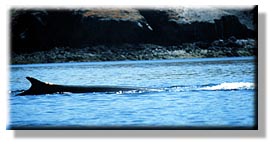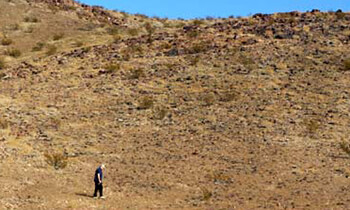Desert Cetaceans
Sea of Cortez
Texy by A.R. Royo -
Photos by Dan Nougier
The Sea of Cortez contains a rich and diverse marine life, including a number of marine mammals called Cetaceans. Among the more prominent species of these mammals residing in the Gulf of California's Sonoran Desert are the Finback Whale, the California Sea Lion and the Common Dolphin.

The Finback Whale
A resident population of 250 Finback Whales (Balaenoptera physalus) feed in the rich waters of the Gulf and are often seen in the Canal de Ballenas (Channel of the Whales), the deep chasm between the Baja mainland and Isla Angel de la Guardia. Finbacks, the second largest animal on the planet, are the most common whale within the island channels, although Killer Whales, Humpback Whales and Sperm Whales are also seen.
The Finback (also called Finner and Fin Whale) is exceeded in size only by its cousin, the Blue Whale; both are baleen, or toothless, whales. Finbacks can reach a length of 80 feet and weigh as much as 80 tons. The Finback is streamlined with a pointed snout, is milky-white underneath and gray-black on top. Its name comes from the extremely small, hooked fin on its back, which is only a foot long in adults.

This huge predator feeds on krill, one of the tinniest of all shrimp-like crustaceans, as well as algae, codfish, herring, sardines, squid, anchovies and octupi. The Finback can remain underwater for 20 to 30 minutes before rising for air, but it is erratic in its cycle and is therefore difficult to track.
The Finback is extremely gregarious, showing no fear of boats and usually travels in pods of 15 to 20, although groups as large as 100 have been seen. The Finback is monogamous and is extremely affectionate and loyal to its partner. They breed May through August and give birth the following year to a 20- to 25-foot-long offspring, which is nursed for 6 months.
The California Sea Lion
The California Sea Lion (Zalophus californianus) is composed of 3 geographically isolated populations numbering between 70,000 and 150,000. The great majority of these live between the Farallon Islands near San Francisco and the Gulf of California south to the tip of Baja.
California Sea Lions usually come ashore on the windward sides of cool, fog-shrouded islands, offshore rocks or islets. Members of the Otariidae Family (eared seals) are usually found only in temperate and subtropical regions.
On fairly warm days, seal lions stay continually wet in tide pools and by rolling in wet sand to keep cool. After extensive swimming and diving, they may be seen in the water waving one flipper, another means of dissipating heat.
The adult male may reach a length of 8 feet and weigh as much as 600 pounds. The adult female will reach only 6 feet and weigh a third as much.
In order to breed, sea lions establish rookeries, special breeding grounds where sea lions congregate. The breeding males, 5 years and older, arrive at the rookeries first in early spring and battle other males until relatively few are left. The dominant males shift territory with time of day, level of tides, temperature and location of females. The harem size of a bull varies between 10 and 20 females.
Females begin to breed at about 3 years of age. Shortly after arriving at the rookery, she gives birth to a single pup, then a few days later, she will go into heat and is bred. After a gestation period of 342 to 365 days, the pup is born and will nurse for up to 4 months. By mid August, when the breeding seasons ends, sea lions scatter along the coast, males and females going in opposite directions, until the following spring.
The Common Dolphin
The Common Dolphin (Delphinis delphis) has black flippers and back with yellowish flanks and a white belly. It swims at about 25 mph in medium-size schools, enjoying the warm and temperate waters of the Atlantic and Pacific Oceans. It has 30 to 40 small teeth and each side of its lower and upper jaw and reaches a length of about 8 feet.
Share this page on Facebook:
The Desert Environment
The North American Deserts
Desert Geological Terms







